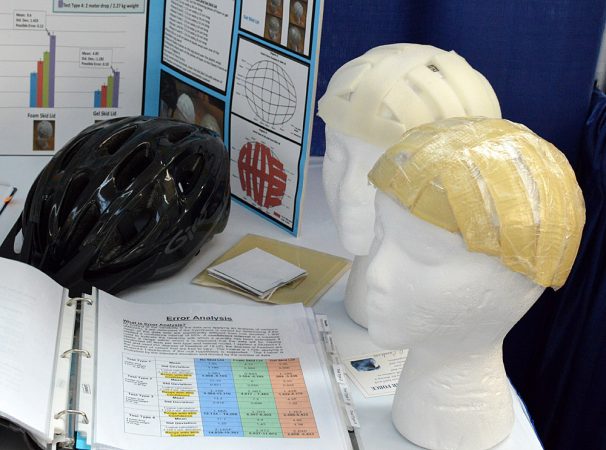Helmet helper
Gel-filled liner absorbs energy of impacts, may reduce sports-related head injuries
By Sid Perkins

There’s no such thing as a good smack to the head.
Whether you ski down a mountain, play football, or skate with the big boys on a hockey rink, you’re at risk of a sports-related head injury. But the statistics of injuries related to bicycling are what inspired Claire Longcroft, a 16-year-old 11th-grader at Collingwood School in West Vancouver, British Columbia, to design an energy-absorbing liner for helmets.
In cycling accidents, she notes, riders strike their heads about 38 percent of the time; for children, the rate is an even higher 55 percent. Furthermore, a whopping 10 percent of all trauma deaths in children result from head injuries while cycling.
A large share of the more serious head injuries involve what are called concussions. It’s a type of brain damage caused by a shaking of the head or serious blow to the head. Concussion can cause headaches and even a temporary loss of consciousness. Afterwards, patients may suffer memory loss and fuzzy thinking for periods lasting from hours to weeks. According to the Centers for Disease Control and Prevention,U.S.emergency rooms treat some 135,000 brain traumas (including concussions among school-age children).
Beyond these general statistics, however, Longcroft has personally witnessed the effects such accidents can have. Her dad is an avid bicyclist. During a group ride two years ago, another rider crashed his bike. Today, that gentleman is still suffering lingering effects of traumatic brain injury, including persistent pain and some degree of memory loss.
Longcroft’s invention — the “Skid Lid Helmet Helper” — is a cap-like liner that fits against a rider’s head. The liner is made of 1-centimeter-thick strips filled with a viscoelastic gel. This gel squishes to absorb energy from an impact, distributing it across a broad area. Later, it slowly springs back into its original shape.

The high-school engineer tested her new liner using the same sort of tests used by the manufacturers who make bike helmets. For instance, she dropped 3-pound and 5-pound weights onto the helmet from heights of 1 meter and 2 meters. Results of 240 such trials hint that the liner will offer some protection against concussions and traumatic brain injuries, Longcroft reported May 15 at the Intel International Science and Engineering Fair in Pittsburgh, Pa.This event is sponsored by Intel Foundation and run by the Society for Science & the Public (which publishes Science News for Kids).
A standard bike helmet (with styrofoam padding) may absorb about 88 percent of the energy of an impact. Longcroft’s results suggest that if the same helmet also included a Skid Lid, it could protect the head from about 97 percent of an impact’s energy.
Besides protecting against sports-related injuries, Skid Lid could be incorporated into hard-hats used by construction workers, which typically are just a thin plastic shell with a system of webbing that holds the hat a few centimeters above the scalp, providing minimal cushioning, Longcroft notes.
This is the first in a series of articles covering the Intel ISEF 2012 competition. Check back soon for more stories.